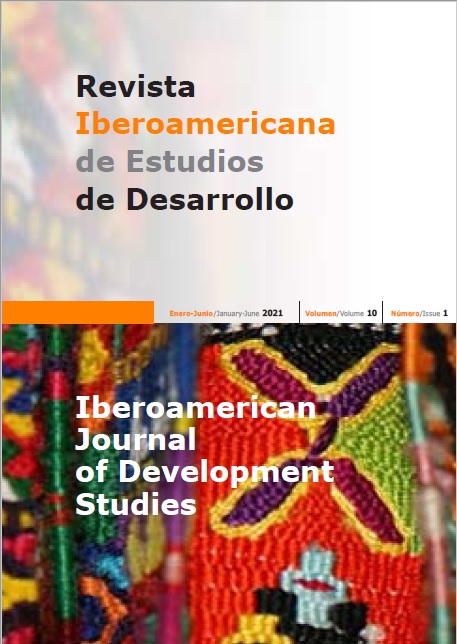Commercial policy impact on furniture, shoes and clothing’s income and price elasticity in Argentina 2003-2015
DOI:
https://doi.org/10.26754/ojs_ried/ijds.450Keywords:
Commercial Policy, international trade elasticities, DJAI, LNA, ArgentinaAbstract
The objective of this paper is to evaluate the impact of trade administration policy, particularly
Non-Automatic Licenses (LNA, Spanish initials) and the Anticipatory Imports Declaration (DJAI,
Spanish initials), on the price and income elasticities of imports into Argentina, based on customs
microdata, for the furniture, footwear and clothing sectors between 2003 and 2015. As a result
of the intensification of these measures in 2008, and subsequently in 2012, both the LNA and the
DJAI reduced the average elasticities for all affected sectors, from ‒1.13 to ‒0.2 in the case of price
elasticity and from 4 to 2.5 in the case of income elasticity. Structural change tests and projection of
alternative scenarios were run to give robustness to the estimate. This implies that the trade policy
measures implemented were effective instruments for moderating import growth in the recovery
phase of the economic cycle after the international crisis.
Downloads
References
BERRETTONI D, CASTRESANA S (2009). Elasticidades de comercio de la Argentina para el período 1993-2008. Revista del CEI. Comercio Exterior e Integración 16.
BUS A, NICOLINI-LLOSA J (2007). Importaciones de Argentina, una estimación econométrica. XLII Reunión Anual de la AAEP, Universidad Nacional del Sur.
BUSSIÈRE M, GAULIER G, STEINGRESS W (2017). Global Trade Flows: Revisiting the Exchange Rate Elasticities. Bank of Canada.
CATÃO L, FALCETTI E (2002). Determinants of Argentina’s External Trade. Journal of Applied Econometrics 1:1, mayo.
CHANG H-J (2003). Rethinking Development Economics. Anthem Press, Londres.
CHANG H-J (2004). Pateando la escalera. Universidad de Cambridge, Cambridge.
CIMOLI M, LAVARELLO P, ABELES M (2017). ¿De qué hablamos cuando hablamos de política industrial? En: Manufactura y cambio estructural Aportes para pensar la política industrial en la Argentina. Cepal, Santiago de Chile.
DALLE D, LAVOPA F (2010). Managed Exports and the Recovery of World Trade: The 7th GTA report A Focus on Latin America: In Case of Fire, Break the Glass: Argentina’s Border Emergency ‒ Kit in Times of Global Crisis. Global Trade Alert.
DE ÁNGELIS J (2017). El comportamiento de las importaciones industriales en el período 2003-2011: una aproximación a su dinámica sectorial. Tesis doctoral. Universidad Nacional de Quilmes.
DÍAZ-ALEJANDRO CF (1970). Ensayos sobre la historia económica argentina, vol. 975. Buenos Aires: Amorrortu.
DICOVSKIY J, GROSSO J (2009). Importaciones, descripción e impacto de las medidas de política comercial. Ministerio de Economía y Finanzas Públicas, Buenos Aires.
GARRIS A, PANIGO D, MEDICI F, GALLO P (2012). El comportamiento de las importaciones industriales en el período 2003-2011: una aproximación a su dinámica sectorial.
GK, DA (2006). The WTO and the Shrinking of Development Space. How big is the Bite? GD Institute, Ed.
HEYN I, MOLDOVAN P (2011). La política comercial en las Estructuras Productivas Desequilibradas: el caso de las licencias no automáticas de importación. En: Ensayos en honor a Marcelo Diamand. Ensayos en honor a Marcelo Diamand. Las raíces del nuevo modelo de desarrollo argentino. Universidad Nacional de Moreno.
MONDINO L, RAMPININI AV (2018). Política comercial inteligente frente a un mundo convulsionado. En: Hay otro camino: economía política para el empleo, el crecimiento y la justicia social. Rossi, A. Ediciones Colihue.
OMC (2013). Trade Policy Review 277.
OMC (2016). https://www.wto.org/spanish/news_s/news16_s/dgra_18jul16_s.htm , acceso 18 de julio de 2016, 18 de julio.
OTTONE (2016). Elasticidades del Comercio Exterior en la Convertibilidad y Posconvertibilidad Argentina. En: Apel (ed.), II Congreso de Pensamiento Económico Latinoamericano.
PADILLA PÉREZ R (2014). Fortalecimiento de las cadenas de valor como instrumento de la política industrial. Metodología y experiencia de la Cepal en Centroamérica. Cepal, Santiago de Chile.
RAMPININI A (2016). El impacto de las Licencias No Automáticas en el sector Muebles y la Cadena Foresto Industrial de Argentina, durante el período 2009 al 2012. UBA, editor. http://bibliotecadigital.econ.uba.ar/download/tpos/1502-1084_RampininiAV.pdf , acceso 29 de marzo de 2019.
TUSSIE D, CURRAN L (2010). Crisis y proteccionismo de rescate: algunas tendencias. Documento de trabajo Nro. 47. Flacso, Buenos Aires.
ZACK G, DALLE D (2015). Elasticidades del comercio exterior de la Argentina: ¿una limitación para el crecimiento? Realidad Económica.
Downloads
Published
How to Cite
Issue
Section
License
Copyright (c) 2021 Anahi Verónica Rampinini, Nicolás Hernán Zeolla, Lisandro Mondino

This work is licensed under a Creative Commons Attribution-NonCommercial-NoDerivatives 4.0 International License.








